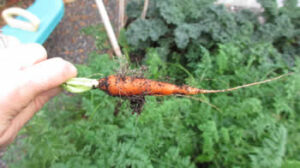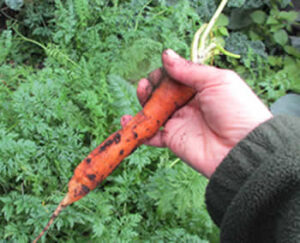Prior to this past summer, I was never able to grow carrots. They emerged from the ground looking like… well, God forgive me, let’s call them my little orange Thalidomide babies. But then I tried something different. First, I did some research on how to grow carrots. Then I employed some of the new techniques that I had learned about.
And then, a glorious thing happened. Not only did I manage to coax to life a crop of carrots that were straight and strong, thick and sweet… but the carrot bed continues to yield well into November and will probably keep on going for another two months at least.

What did I do? Allow me to share:
Added sand to the soil. If you want to avoid gnarly, funny looking carrot fingers, or carrots that look like a stubby little man on stout, knobby legs, then mix some sand into a good garden loam, and this should correct the problem.
Broadcast the seed in its own “carrot patch” section. I guess this is the lazy woman’s way to plant seeds; well, that’s what I did. We didn’t have carrot rows, we had a carrot patch. I suppose this may have helped me save time. At any rate, it allowed me to limit the spread of sand to other veggies who may not appreciate it as much.
Composted. At least 4 times over the course of the garden season, either my husband or I spread around some fresh compost that we had had cooking in our handy compost tumbler. The majority of our compost is leaf mulch and grass clippings, simply because we can’t always seem to make it out to the backyard with our kitchen waste. But the brown/green organic matter combo is still excellent, and really seems to keep our plants going. The carrots enjoy it, although I will say that I was only able to get the compost around the perimeter of the carrot patch.
Thinned the plants. I am guilty of having planted our carrots too close to each other in the first place. This goes back to my lazy woman’s method of broadcasting the seeds. Despite this, a continual follow-up routine of pulling a sacrificial carrot plant here and there seemed to do the trick. The carrots need space from each other so that each root can fully form under the ground. If you aren’t sure how much space, just consider how big you want your carrots to be, and then if you leave that much room. That’s how much they’ll grow.
Did not give up on my carrots! I believe that one of the major underlying reasons for my carrot-growing success is that I actually did not give up on the little guys. It’s easy to plant a garden in May and be all gung-go about it until August, when you’ve just returned from your summer vacation in time to see the unwatered plants choking out their last breaths of life. But even if something like this happens to you, it doesn’t mean your gardening career is over or that the season is done. It just means you have to get back out there and show your carrots some love. That’s what I did.
Waited. And waited. And waited! Carrots, at least the breed I purchased from Burpee, are late to mature. You might plant your carrot seeds in May as I did, and then find yourself tapping that foot impatiently, wondering if they’ll ever turn into mature, edible specimen. I finally pulled my first fully grown carrot root in September. But the reward in this is that now that the cool weather is here, my carrot crop is going strong and they’ve become an easy-access staple for all my fall comfort foods!

Continued to thin the carrot patch well into autumn. This is actually key. We talked earlier about making sure to thin the plants. Even after I began pulling mature carrots in September, I still encountered many more little babies that weren’t nearly ready to be picked. I either pushed these back into the ground (in another, more open area) for further development, or simply disposed of them, as they were still crowding each other out and inhibiting growth. My reward for doing this was that the carrots that I gave more space to continue to mature into big, fat carrot-daddies, and it is now November. So, I am really enjoying the fruit of my carrot-gardening labor!
A final bonus to thinning and harvesting carrots in autumn and winter: the carrots become sweeter the longer they stay underground! The same thing in fact does happen with carrots that are picked and stored. (Your supermarket carrots remain in storage for quite a long time until eaten, which is why the ones you buy in the orange tinted bag taste so much sweeter than the fresh organic ones with the tops still on).
